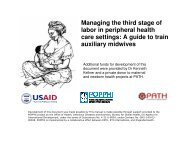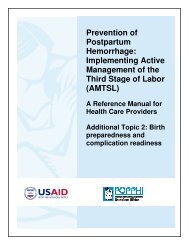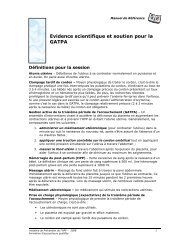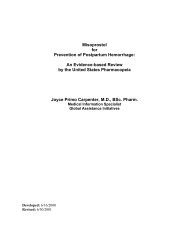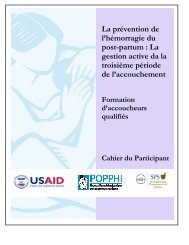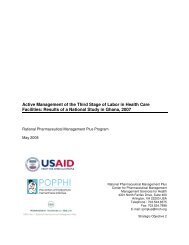Implementing Active Management of the Third Stage of Labor
Implementing Active Management of the Third Stage of Labor
Implementing Active Management of the Third Stage of Labor
Create successful ePaper yourself
Turn your PDF publications into a flip-book with our unique Google optimized e-Paper software.
Reference manual<br />
Innovative techniques<br />
O<strong>the</strong>r promising techniques appropriate for low resource settings for assessment and treatment <strong>of</strong> PPH<br />
include easy and accurate blood loss measurement, 14, 15 oxytocin in Uniject, 16 uterine tamponade, 17 and<br />
<strong>the</strong> anti-shock garment. 18 These innovations are still under investigation for use in low resource<br />
settings but may prove programmatically important, especially for women living far from skilled care.<br />
Research Needs<br />
Important strides have been made in identifying life-saving approaches and interventions appropriate<br />
for PPH prevention and treatment in low resource settings. The field is rapidly evolving and <strong>the</strong><br />
following issues have been identified as priorities for fur<strong>the</strong>r research in low resource settings:<br />
<br />
<br />
<br />
<br />
<br />
Determine <strong>the</strong> optimal dose and route <strong>of</strong> misoprostol for prevention and treatment <strong>of</strong> PPH that<br />
will still be highly effective but will minimize <strong>the</strong> risk <strong>of</strong> side effects.<br />
Determine <strong>the</strong> most effective method <strong>of</strong> third stage management when no uterotonics are<br />
available.<br />
Assess <strong>the</strong> impact <strong>of</strong> better measurement <strong>of</strong> blood loss (e.g. with a calibrated drape or o<strong>the</strong>r<br />
means) on birth attendants’ delivery practices.<br />
Assess options for treatment <strong>of</strong> PPH in lower-level (basic EmOC) facilities, in particular, uterine<br />
tamponade and <strong>the</strong> anti-shock garment.<br />
Identify <strong>the</strong> most efficient and effective means <strong>of</strong> teaching and supporting <strong>the</strong> skills needed by<br />
birth attendants and for community empowerment to address PPH.<br />
References<br />
1. International Confederation <strong>of</strong> Midwives, International Federation <strong>of</strong> Gynaecology and Obstetrics.<br />
Joint statement management <strong>of</strong> <strong>the</strong> third stage <strong>of</strong> labour to prevent post-partum haemorrhage.<br />
The Hague: ICM; London: FIGO; 2003. Available at:<br />
http://www.internationalmidwives.org/modules/ContentExpress/img_repository/final%20joint%20<br />
statement%20active%20manange ment-eng%20with%20logo.pdf or<br />
http://www.figo.org/content/PDF/PPH%20Joint%20Statement.pdf. Retrieved October 12, 2006.<br />
2. Khan KS, Wojdyla D, Say L, Gulmezoglu AM, Van Look PF. WHO analysis <strong>of</strong> causes <strong>of</strong> maternal<br />
death: a systematic review. Lancet 2006;367:1066-74. DOI:10.1016/S0140-6736(06)68397-9.<br />
3. United Nations. Millennium Development Goals. New York (NY): UN; 2000. Available at:<br />
http://www.un.org/millenniumgoals. Retrieved October 12, 2006.<br />
4. Prendiville WJ, Elbourne D, McDonald S. <strong>Active</strong> versus expectant management in <strong>the</strong> third stage <strong>of</strong><br />
labour. Cochrane Database <strong>of</strong> Systematic Reviews 2000, Issue 3. Art. No.: CD000007. DOI:<br />
10.1002/14651858.CD000007.<br />
5. Hogerzeil HV, Walker GJ, de Goeje MJ. Stability <strong>of</strong> injectable oxytocics in tropical climates: results<br />
<strong>of</strong> field surveys and simulation studies on ergometrine, methylergometrine, and oxytocin. Geneva:<br />
Action Programme on Essential Drugs and Vaccines, World Health Organization; 1993. WHO<br />
Publication No. WHO/DPA/93.6.<br />
6 Ceriani Cernandas JM, Carroli G, Pellegrini L, Otano L, Ferreira M, Ricci C, et al. The effect <strong>of</strong> timing<br />
<strong>of</strong> cord clamping on neonatal venous hematocrit values and clinical outcome at term: a randomized,<br />
controlled trial. Pediatrics 2006;117:e779-86.<br />
7. Derman RJ, Kodkany BS, Goudar SS, Gellar SE, Naik VA, Bellad M, et al. Oral misoprostol in<br />
preventing postpartum haemorrhage in resource-poor communities: a randomised controlled trial.<br />
Lancet 2006;368:1248-53.<br />
8. Høj L, Cardoso P, Nielsen BB, Hvidman L, Nielsen J, Aaby P. Effect <strong>of</strong> sublingual misoprostol on<br />
severe postpartum haemorrhage in a primary health centre in Guinea-Bissau: randomised double<br />
blind clinical trial. BMJ 2005;331:723.<br />
Prevention <strong>of</strong> Postpartum Hemorrhage: <strong>Implementing</strong> <strong>Active</strong> <strong>Management</strong> <strong>of</strong> <strong>the</strong> <strong>Third</strong> <strong>Stage</strong> <strong>of</strong> <strong>Labor</strong> 9



